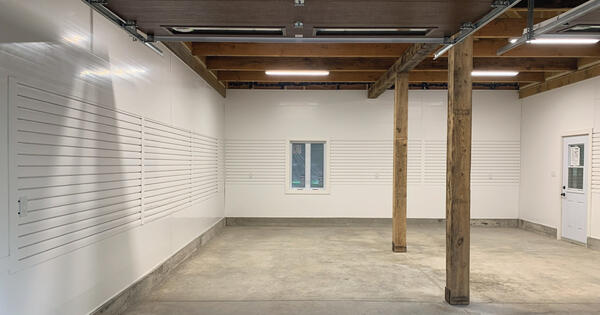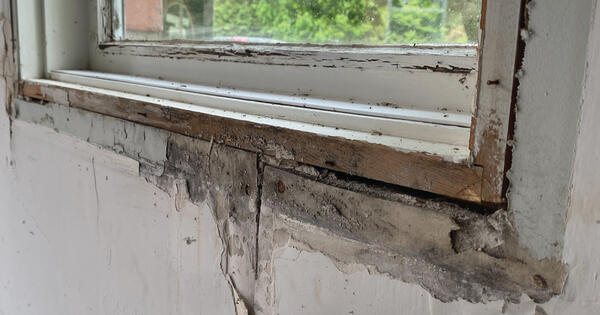If you've ever taken on a home renovation or flipped through a DIY video, you've probably heard the terms "Sheetrock" and "drywall" thrown around like they mean the same thing. And for most people, they do. But while they’re closely related, they’re not identical.
Drywall is one of the most commonly used building materials in residential construction, so knowing what you're working with can make a difference when it comes to performance, cost, and product selection. And beyond drywall and Sheetrock, there are also newer materials on the market — like Trusscore Wall&CeilingBoard — that offer alternatives with benefits traditional options can’t match. Understanding your choices is the first step toward choosing the right one for your space.


What’s the Difference Between Sheetrock vs. Drywall?
Let’s clear up a common point of confusion: Drywall is the material, and Sheetrock is a brand name for one type of drywall. It’s similar to how people say “Kleenex” when they really mean “tissue.” Sheetrock is made by the United States Gypsum Company (UGC) and has become so well known that many use the name to refer to drywall in general.
Both drywall and Sheetrock are made from the same core material — gypsum — pressed between two layers of thick paper. But Sheetrock may include proprietary ingredients or manufacturing tweaks depending on the product line. That could mean added mold resistance, lighter weight, or improved fire ratings, depending on the version you choose.
Here’s a quick breakdown to help clarify the distinction:
- Drywall is the generic material: Made from a gypsum core between paper facings, used for interior walls and ceilings.
- Sheetrock is a specific brand of drywall: Manufactured by USG, often includes performance enhancements and proprietary formulations.
- They’re often used interchangeably: Most homeowners and even some contractors use the terms as synonyms, even though one is a brand.
Understanding this nuance might not change your entire renovation plan, but it can help you compare products more accurately if you're looking for performance features like moisture or impact resistance.
Pros and Cons of Using Drywall (or Sheetrock)
Drywall has earned its place as a staple in residential construction. It’s affordable, easy to find, and relatively simple to install in most rooms. But while it's the standard, it's not without its challenges. Here’s a closer look at the benefits and drawbacks of using drywall or Sheetrock in your home:
| Pros of Drywall | Cons of Drywall |
|---|---|
| Cost-effective and widely available: Drywall is inexpensive and easy to source from nearly any hardware or building supply store. | Vulnerable to moisture: Drywall soaks up water, which can lead to swelling, sagging, mold, and mildew in damp or humid environments like basements, bathrooms, or laundry rooms. |
| Simple to cut and install: With the right tools, it’s fairly straightforward to measure, cut, and hang in rooms with square corners and standard dimensions. | Prone to damage: It doesn’t take much to dent, crack, or puncture a drywall surface, which can lead to frequent repairs over time. |
| Fire-resistant by design: The gypsum core in drywall contains water, which offers some fire resistance and can help slow the spread of flames. | Messy installation and repair: Cutting, sanding, and mudding drywall creates a lot of dust and requires cleanup. Repairs can be just as disruptive. |
| Finishing adds time and effort: Drywall installation isn’t truly complete until it’s taped, mudded, sanded smooth, and painted. Each step adds to your timeline and labor. |
Drywall may work well for standard rooms, but in high-traffic or high-moisture areas, those weaknesses can quickly become frustrating and costly. That’s where alternatives like Trusscore Wall&CeilingBoard come in.
Meet the Alternative: Trusscore Wall&CeilingBoard
Drywall may be the industry default, but it’s not your only option. If you're renovating a space like a basement, garage, laundry room, or utility area, you’ll want something that’s tougher, faster to install, and built to handle more than just dry conditions.
Trusscore Wall&CeilingBoard is a PVC-based wall and ceiling panel system that’s engineered to outperform traditional drywall in the places it struggles most.
Here’s what sets Trusscore apart:
- Installs quickly and cleanly: Panels click together with a tongue-and-groove system and install with screws — no mudding, sanding, or painting required.
- 100% waterproof: Unlike drywall, Trusscore won’t absorb moisture, warp, or support mold and mildew.
- Durable and impact-resistant: It’s built to stand up to bumps, scrapes, and wear and tear that would damage drywall.
- Bright, clean finish: The white, glossy surface reflects light and creates a clean, finished look. No paint needed.
Drywall has had a long run but building materials have come a long way. With Trusscore, you get a modern alternative that’s purpose-built for performance and longevity.
Trusscore vs. Drywall: How Do They Compare?
When you’re choosing materials for walls and ceilings, it’s important to understand how they stack up in key areas like durability, moisture resistance, installation, and overall maintenance. Drywall might be the traditional choice, but Trusscore Wall&CeilingBoard is designed to solve the problems drywall can’t.
| Feature | Drywall (Sheetrock) | Trusscore Wall&CeilingBoard |
|---|---|---|
| Material |
Made from a gypsum core sandwiched between two sheets of paper. |
Constructed from a durable, rigid PVC polymer that’s lightweight and engineered to last. |
| Moisture Resistance |
Absorbs moisture easily, which can lead to swelling, warping, or complete failure over time. |
Completely waterproof — won’t absorb water, warp, or deteriorate in humid or wet environments. |
| Mold/Mildew Resistance |
Susceptible to mold and mildew in damp areas like basements or bathrooms. |
Resists mold and mildew thanks to its non-organic, non-porous surface. |
| Durability |
Prone to cracks, dents, and holes from everyday wear and tear or accidental impact. |
Highly impact-resistant and built to withstand bumps, scrapes, and frequent use. |
| Installation |
Labor-intensive — requires hanging, taping, mudding, sanding, and painting, often over several days. |
Installs quickly with a tongue-and-groove system; no mudding, sanding, or painting required. |
| Cleanability |
Porous and textured surface can trap dirt and stains, making it difficult to clean thoroughly. |
Smooth and non-porous surface wipes clean with ease — no staining or scrubbing needed. |
| Aesthetic Options |
Needs paint, texture, or wallpaper to achieve a finished look. |
Available in a bright, clean white finish or as a SlatWall panel for integrated storage. |
| Best Use Cases |
Works well in dry, climate-controlled areas like bedrooms, living rooms, and hallways. |
Ideal for high-moisture or utility spaces such as basements, garages, laundry rooms, and workshops. |
While drywall remains a common go-to for standard interior walls, it’s not always the best fit, especially in areas where moisture, durability, or ease of maintenance are priorities. Trusscore Wall&CeilingBoard offers a modern solution designed to handle what drywall can’t, without compromising on style or function.
When to Choose Drywall (or Sheetrock) vs. Trusscore
Not every room in your home has the same needs. Choosing the right wall and ceiling material starts with understanding how the space will be used — and what kind of wear, moisture, or maintenance it’s likely to face.
Use drywall or Sheetrock in:
- Bedrooms and living rooms: These areas are generally dry, climate-controlled, and low-impact, making traditional drywall a suitable and cost-effective choice.
- Home offices or dens: In quiet, low-traffic rooms where performance isn’t a top priority, drywall holds up just fine.
Use Trusscore Wall&CeilingBoard in:
- Garages and workshops: These spaces are prone to dents, dirt, and humidity. Trusscore durability and wipe-clean surface make it a much better fit.
- Basements and laundry rooms: High moisture levels can quickly damage drywall. Waterproof Trusscore panels resist mold and mildew, helping to protect your home.
- Mudrooms and utility areas: These are high-traffic zones where durability and cleanability matter more than aesthetics alone.
- Commercial or semi-industrial spaces: If you’re renovating a space that needs to meet stricter hygiene standards or handle frequent cleaning, Trusscore is a reliable, long-lasting option.
Think of drywall as the traditional choice for finished living spaces, and Trusscore as the better-performing solution for the parts of your home that work harder and need materials to match.



Cost Comparison: Is Trusscore More Expensive Than Drywall?
At first glance, drywall is the more budget-friendly option. A standard drywall panel is cheaper than a Trusscore panel, which might make it seem like the obvious choice. But the full cost of a wall or ceiling goes far beyond the price of the panel itself.
Here’s what to consider:
- Drywall costs less up front: It’s inexpensive to purchase, but the installation process — cutting, hanging, taping, mudding, sanding, and painting — takes time, labor, and extra materials.
- Trusscore has a higher initial cost: But it installs faster, requires no finishing, and creates less mess and downtime. That means lower labor costs if you’re hiring a pro, and far less hassle if you’re doing it yourself.
- Maintenance matters: Drywall often needs patching, repainting, or replacing, especially in damp or high-traffic areas. Trusscore, on the other hand, resists damage and wipes clean, so maintenance costs over time are next to nothing.
In the long run, Trusscore delivers more value where it counts. You’re paying not just for the panel but for peace of mind, cleanliness, and a material that’s built to last.
Drywall and Sheetrock have been the go-to materials in residential construction for decades and for many rooms in your home, they still make sense. But just because it’s common doesn’t mean it’s always the best choice. For the areas of your home that see more moisture, mess, or wear and tear, Trusscore Wall&CeilingBoard offers a smarter, more durable alternative. It installs faster, cleans easier, and stands up to the kinds of conditions that cause drywall to fail.






